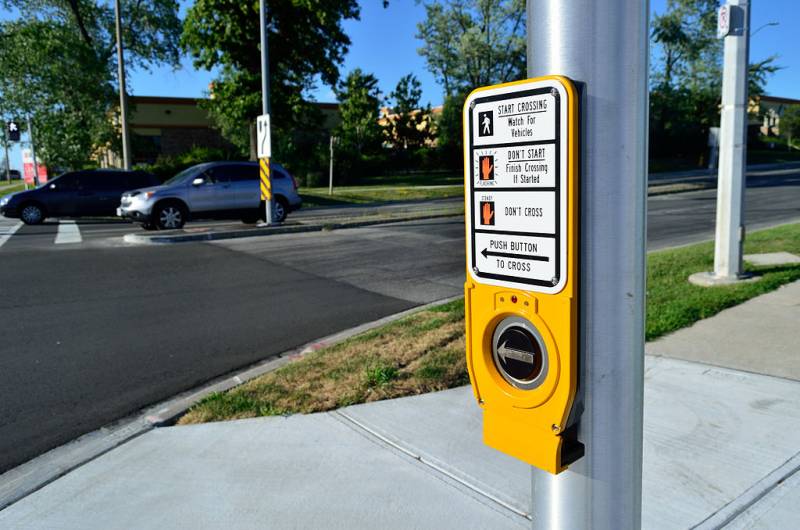Whether you realize it or not, you’ve almost certainly interacted with an accessible pedestrian signal, or APS. These are the crosswalk systems designed with sonic and tactile cues to help blind and visually impaired pedestrians know when they can cross the street. The sounds and buttons tell them when the “walk” sign is lit up. You’ll find these APS systems installed at hundreds of intersections around San Francisco, and thousands more across the country. In San Francisco, most are framed in a yellow casing and have a raised arrow on the pedestrian crossing button.
One Bay Curious listener had some questions about why they sound the way they do and how they work. Here’s what we found.
Why does San Francisco’s crosswalk system make a machine gun sound?
That sound has an official name: the rapid tick. It’s the sound currently recommended by federal and state guidelines.
In the 1980s and ’90s, research was done on which APS signals were most effective. The overhead cuckoo-chirp signals, which are installed in many parts of the U.S., did not fare particularly well.
“People got confused and felt they needed to know the orientation of a cuckoo or chirp,” says Gene Lozano, a retired rehabilitation counselor from California State University, Sacramento, whose been involved in transportation accessibility for decades.
“Cuckoos” sounded for the north-south direction of travel. And the “chirp-chirp” was for east-west.
“People who were blind or had low vision felt they had to know the compass direction of an intersection, and people got intimidated by that,” Lozano says.
And there was another problem with the bird sounds.
“In some parts of the country there were reports that some birds, like mockingbirds, were able to replicate that sound,” he says.
The study found the rapid tick sound, instead, helped pedestrians make faster, more accurate decisions when at a crosswalk. It is now the recommended sound, except in certain cases. When the crosswalk heads are less than 10 feet apart — for example when the buttons for intersecting streets are mounted on a single pole — a verbal announcement is preferred to help people differentiate which street’s “walk” sign is lit. While the verbal announcement seems like it would be a superior option in all cases, it requires the pedestrian to speak the language in which the message is delivered.
If you come across an intersection with the cuckoos and chirps, it’s likely an older system that hasn’t been updated.
What other features are built into San Francisco’s accessible pedestrian systems?
To learn the ins and outs of how the system is used, we got a demonstration from Frank Welte, a senior braille and accessible media specialist at the LightHouse for the Blind and Visually Impaired in San Francisco.
We met outside a Civic Center BART entrance, on the south side of Market Street, between 7th and 8th streets.
“I’m walking up to the crosswalk here, and you’ll hear the locator tone,” Welte said as he approached the street pole where the crosswalk system was mounted. It was emitting a beeping sound about once per second.
“And I’m positioning myself so the signal is to my right,” he says, as he presses the crosswalk button. “On the button is a little arrow that points in the way that you’re supposed to cross. It’s a tactile arrow you can feel. When the signal goes off that tactile arrow starts to vibrate. So if I were deaf-blind or hard of hearing, by holding the tactile button I know when the signal goes off. I often do that anyway just because it’s a confirmation on a noisy day like today that I’m reading the signal correctly.”
The signal changes to “walk,” and the rapid tick sound plays. Welte walks through the intersection, listening for the speaker on the opposite side of the street to help guide him to where the curb is cut. In a matter of seconds, we’re across the street and in UN Plaza.
One final tip Welte shows me: If you press the crosswalk button for a few seconds, an announcement plays telling you what street you are set up to cross or the intersection you’re standing at.
How do blind people cross the street without audible signals?
“We follow the traffic patterns,” Welte says. “When one set of traffic goes, I go, and when that traffic isn’t going, I stay still. So when you come to a traffic light, that’s one more reason you don’t want to run a red light. It’s because I am assuming that if you’re not moving, the light is doing a certain thing.”
Still, Welte prefers the confirmation that an accessible pedestrian signal provides.
“When you have complicated intersections, for example all these angled streets we have coming into Market Street, that can make the pattern more complicated and harder to read. So having that accessible signal is a huge help.”
According to the San Francisco Municipal Transportation Agency website, there are 283 APS intersections in San Francisco and 85 more that have been requested.
Further reading:
- Crossroads: Modern Interactive Intersections and Accessible Pedestrian Signals
- An Architect Who Listens to Buildings
Annika Cline contributed to this story.

